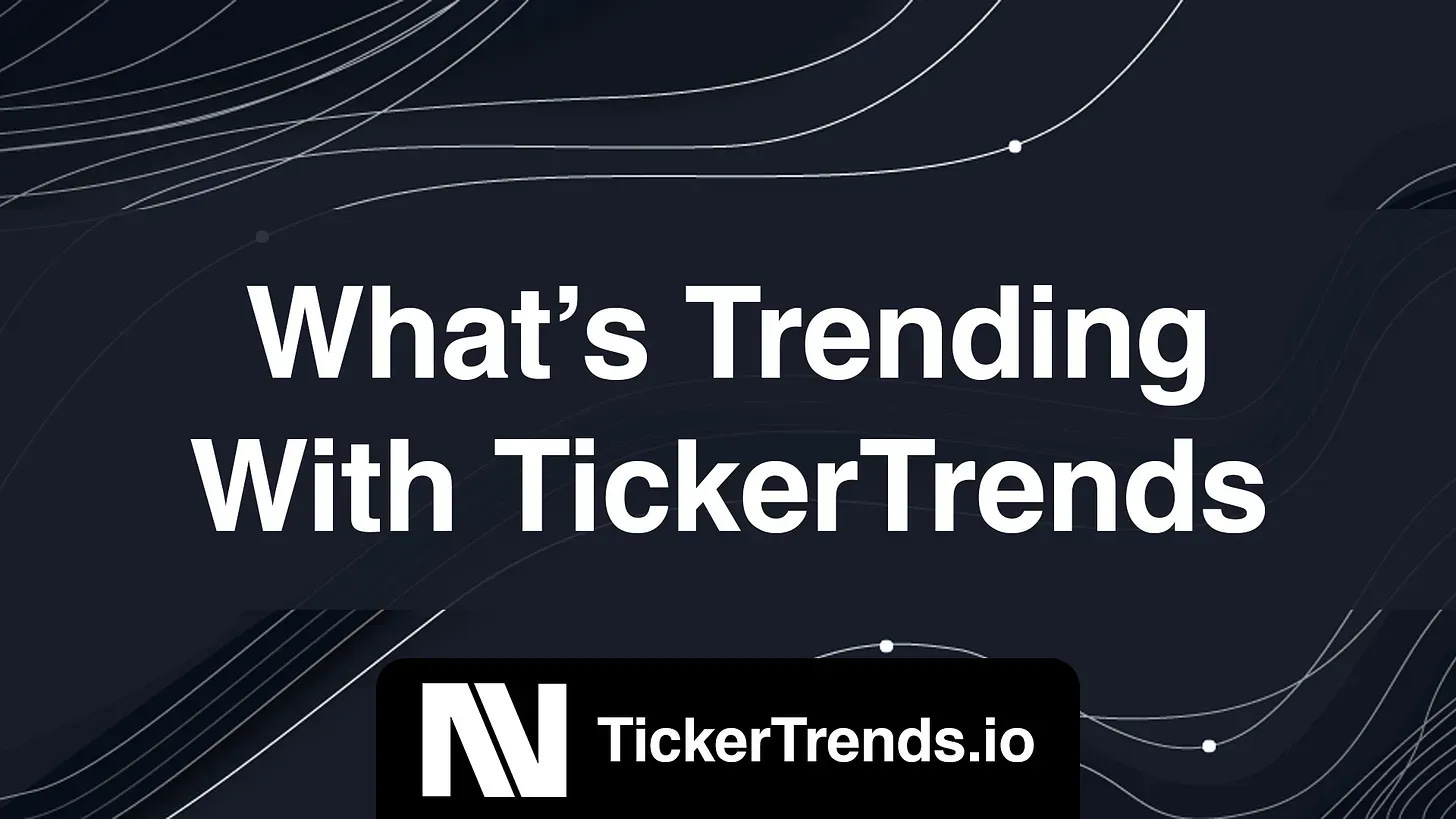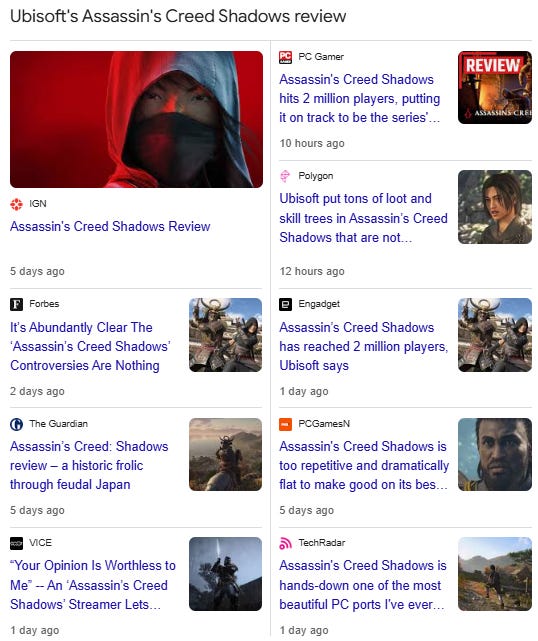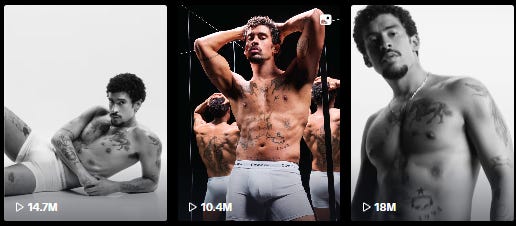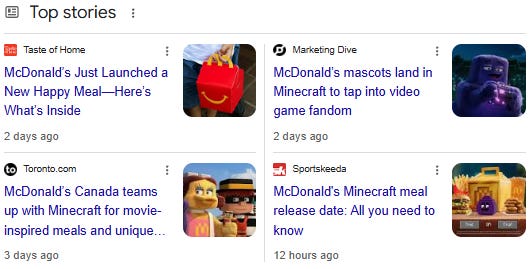What’s Trending with TickerTrends #24
TickerTrend’s Monday Monitor is our overview of interesting social arbitrage event-driven trades and companies that could potentially benefit from these. Join us on X or join our Discord.
Enjoy!
Disclaimer. This newsletter is provided for informative purposes only. No significant due diligence has (yet) been performed on the names on this list. This overview does not constitute advice; always do your own due diligence.
Thanks for reading TickerTrends. Subscribe for free to receive new posts. Also, subscribe to our platform and support our work.
Important notice: We would like to continue to publish WTWT on a weekly basis, but we need a more critical mass. If you value this service, please like and hit the “share” button below. Thank you.
TickerTrends Research is a reader-supported publication. To receive new posts and support my work, consider becoming a free or paid subscriber.
Earnings Recap:
No significant earnings to report this week.
Trends this week:
Primo Brands Corporation ($PRMW.TO):
The top trend as per our social discover feature this week is Saratoga Water after Ashton Hall went viral for what might be the most over-the-top morning routine the internet has seen this year. The fitness influencer, who boasts over 8 million Instagram followers and recently hit over $600 million views on X, has sparked a mix of awe, confusion, and mockery after posting a now-famous video titled “The morning routine that changed my life 3:50am to 9:30am.”
The six-hour ritual includes a series of hyper-disciplined tasks: waking up before 4 a.m., brushing his teeth with mouth tape on, doing push-ups on the balcony, sprinting at the gym, journaling with military precision—and most notably, dunking his face in a bowl of ice-cold water twice. The first face plunge happens pre-workout, the second bizarrely follows a shower and full skincare routine, just before he starts a podcast recording at his desk.
Adding to the spectacle is the use of luxury Saratoga Spring Water and lemon slices in the bowl, which has led to widespread memeification. One clip even shows someone handing him the second bowl of ice water like a ceremonial offering. Social media quickly lit up with comments like “What’s with him dunking his face into random bowls of ice water every 3 hours?” and “The second bowl being HANDED to him 10 minutes after washing his face is completely frying me.”
While the internet is laughing, there’s actually science behind the ice water dunk. Known as the mammalian diving reflex, cold water exposure to the face can activate the parasympathetic nervous system, which helps lower heart rate and reduce stress. It’s even used in therapy settings like Dialectical Behavior Therapy (DBT) to help people manage overwhelming emotions.
But Hall’s version—complete with banana peel facials, nose strips, and designer jewelry—takes things to another level. It's a mix of genuine wellness techniques and influencer performance art, and it's sparked conversations about the growing extremism in online self-improvement culture.
As Ashton Hall’s ice water face dunking routine continues to go viral, it’s also generating some unexpected buzz for premium bottled water brands especially Saratoga Spring Water owned by Primo Water Corporation. With more people associating premium water with luxury, health, and influencer aesthetics, Primo—known for its Mountain Valley and Pure Life brands—may see increased consumer demand or marketing opportunities in the wellness and influencer-driven space. If the trend holds, especially among Gen Z and millennial consumers looking to mimic viral habits, Primo could benefit from aligning its branding with this new wave of ritualized hydration and cold therapy culture.
Ubisoft Entertainment SA ($UBI.PA):
Assassin’s Creed Shadows has exploded onto the scene, quickly establishing itself as one of Ubisoft’s most successful launches ever. Within just three days of release, the game surpassed two million players, outpacing the launch numbers of major franchise entries like Assassin’s Creed Origins, Odyssey, and even Valhalla. For Ubisoft, which has struggled in recent years with costly underperformers like Skull and Bones and Star Wars Outlaws, this is more than just a hit—it’s a lifeline.
Set in 16th-century Japan, Shadows embraces a setting that fans have been asking for for nearly two decades. And while its historical fiction leans heavily into genre tropes—wandering ronin, corrupt lords, tragic shinobi—the execution is compelling, thanks in no small part to its dynamic dual protagonists: the battle-hardened Black samurai Yasuke and stealthy Iga ninja Naoe. Their chemistry, both in story and gameplay, provides the heart of the game. And even if stealth remains more effective than brute strength in many encounters, the balance between both characters elevates the experience.
Critically, the success of Shadows could mark a turning point for Ubisoft as a publisher. Not only has the game reinvigorated excitement around a franchise that some felt was beginning to lose its identity, but it also validates the company’s move back to more focused, stylized narratives with refined gameplay loops. From less cluttered maps to tighter mission design and meaningful environmental storytelling, Shadows builds on the lessons of Mirage while pushing into a more expansive and cinematic direction.
This could also have major implications for Ubisoft’s internal strategy. The strong performance of Shadows arrives amid reports of Tencent expanding its involvement in Ubisoft’s IP portfolio. A massive success like this may give Ubisoft more leverage in those talks and could delay or derail rumors of a full-scale acquisition or restructuring. Moreover, it proves there’s still a tremendous appetite for AAA single-player experiences—especially when built around richly rendered historical settings and grounded protagonists with real emotional stakes.
For longtime fans, Shadows doesn’t reinvent the wheel, but it sharpens it. And for Ubisoft, it may very well be the game that keeps the franchise—and the company—rolling forward.
Tesla Inc. ($TSLA):
Tesla has issued yet another major recall for its long-delayed and much-hyped Cybertruck, pulling nearly every unit off the road due to a potentially dangerous design flaw. The recall, announced by the National Highway Traffic Safety Administration (NHTSA), affects over 46,000 Cybertrucks built between November 13, 2023, and February 27, 2025—essentially every unit delivered so far.
At the heart of the issue is a stainless steel panel known as the cant rail, which runs along both sides of the windshield and roof. The NHTSA found that the adhesive used to attach this panel can degrade over time due to environmental embrittlement, potentially causing it to detach while driving and creating a road hazard for other vehicles. Tesla has committed to fixing the issue free of charge using a new adhesive and additional reinforcements, including a mechanical fastener. Owner notification letters are set to be mailed by May 19.
This marks the eighth recall for the Cybertruck since its delivery rollout just 15 months ago. Prior recalls have addressed everything from faulty inverters and stuck accelerator pedals to windshield wiper malfunctions and defective display screens. The frequency and severity of these issues have added to growing concerns about Tesla's quality control, especially for a vehicle that was positioned as a technological leap forward in electric pickups.
Adding to the public scrutiny are viral videos circulating online showing people peeling off Cybertruck panels with their bare hands, further underscoring the concerns over build quality. While Tesla has long touted its innovative approach to automotive design—frequently opting for software-based fixes through over-the-air updates—this latest recall involves a structural flaw that cannot be digitally resolved. The recall comes at a particularly fragile time for Tesla. The company’s stock has fallen 34% so far in 2025. Moreover, the Cybertruck’s slow ramp-up—fewer than 50,000 units delivered despite early claims of 500,000 units annually—underscores the challenges Tesla faces in turning hype into volume production.
On top of all this, the company has been facing a wave of politically charged backlash and even physical attacks. Tesla dealerships, charging stations, and even privately owned vehicles have been vandalized in recent months, and law enforcement has arrested individuals in Colorado and South Carolina in connection with anti-Tesla violence. While these incidents haven't resulted in injuries, they’ve added to the cloud of controversy swirling around Elon Musk’s brand.
For Tesla, this recall is more than a temporary production hiccup—it’s a reputational hit at a time when the company can least afford one. As Tesla tries to fend off rivals and rekindle momentum, regaining public and investor confidence will hinge on more than just flashy designs or viral stunts. Execution, especially around quality and safety, has never mattered more.
PVH Corp ($PVH):
Bad Bunny has once again ignited the internet — this time not with a surprise album drop or an arena tour, but by stripping down for Calvin Klein’s Spring 2025 underwear campaign. Shot by legendary photographer Mario Sorrenti and set to his track “EoO,” the steamy visuals showcase the global superstar in the brand’s Icon Cotton Stretch collection, and have quickly become a cultural moment. The campaign has not only gone viral across TikTok and Instagram, but also attracted high-profile attention — with pop star Shawn Mendes jumping into the comments to drop a simple, but telling “guapo” under Bad Bunny’s Instagram post.
Mendes’ Spanish comment (which translates to “handsome”) has sparked waves of fan reactions, and comes amid his own recent embrace of the language while on tour in Latin America. His public praise for Bad Bunny adds another layer of celebrity-to-celebrity endorsement that’s only amplifying the campaign’s reach.
For Calvin Klein and its parent company PVH Corp., this campaign is nothing short of a marketing home run. The brand has long relied on turning underwear ads into global pop culture moments, from Mark Wahlberg and Justin Bieber to more recent icons like Jeremy Allen White. But with Bad Bunny — arguably the most globally relevant musician of the moment, and one deeply rooted in Latin culture — the brand taps directly into one of the most powerful consumer demographics in fashion: Gen Z and Latino youth.
The move couldn’t come at a more strategic time. PVH is in the midst of revamping its brand portfolio to refocus on core labels like Calvin Klein and Tommy Hilfiger after a few challenging quarters. Bad Bunny’s campaign gives Calvin Klein renewed cultural capital, aligning the brand with authenticity, music, sex appeal, and multicultural identity — all key values for today’s fashion-conscious consumers.
Moreover, this campaign is about more than just steamy photos. In a GQ interview, Bad Bunny revealed the disciplined fitness routine and clean diet he followed to prepare for the shoot, as well as his personal creative input — choosing a song from his latest album to soundtrack the ad. That kind of involvement brings deeper authenticity to the campaign, making it not just a modeling gig but a moment of artistic expression.
In a crowded fashion landscape where influencers come and go, Calvin Klein’s strategy of pairing an enduring heritage brand with a truly global, genre-defying superstar like Bad Bunny may prove to be a sales and brand equity booster. If it translates to stronger direct-to-consumer traffic, social engagement, and international buzz, this could mark an inflection point for PVH as it continues to reshape itself for the modern luxury-casualwear consumer.
With the campaign already dominating social media and trending on TikTok, this could be PVH’s biggest marketing win of the year — and a reminder that the right celebrity, when backed by substance and global fandom, can still make all the difference.
Advanced Micro Devices Inc ($AMD):
AMD’s launch of the RX 9000-series GPUs—particularly the RX 9070 and RX 9070 XT—has delivered an unexpected surge of momentum in its gaming segment, a smaller but still strategically important piece of the company’s portfolio. While AMD is now widely viewed as a data center and AI computing leader—with its EPYC server chips and MI300 AI accelerators driving the majority of revenue growth—the recent RDNA 4 launch shows that the company can still make waves in the consumer GPU space when the value proposition resonates.
Demand for the RX 9000-series has been described by AMD executives as “unprecedented,” with units selling out within days at major retailers globally. Although AMD walked back a widely circulated report claiming it had shipped 200,000 units, the company’s VP and GM of Client Channel Business, David McAfee, emphasized that restocking at MSRP is a top priority and that the supply of Navi 48 chips—the heart of the RX 9000 lineup—is being ramped aggressively to meet consumer demand.
What makes this launch even more notable is the market context. With Nvidia’s latest RTX 5000-series facing availability issues and inflated pricing, AMD has carved out a clear value-focused lane in the midrange segment. Priced at $549 and $599 respectively, the RX 9070 and RX 9070 XT offer near-RTX 4080 levels of performance at a fraction of the cost. This has fueled outsized market share gains in regions like Japan, where AMD now reportedly controls 45% of discrete GPU sales—a remarkable turnaround in a market historically dominated by Nvidia.
Still, it’s important to put these gains in perspective. Gaming GPUs represent a relatively modest contribution to AMD’s top and bottom line in comparison to the data center business. The bulk of AMD’s long-term strategy remains centered on high-performance computing, server chips, and AI infrastructure—areas where the company is competing head-on with Nvidia, Intel, and increasingly specialized players.
That said, the RDNA 4 launch serves as a valuable brand booster for AMD. It reinforces the company’s reputation for delivering strong price-to-performance ratios and helps rebuild goodwill with gamers—a community that often influences broader tech perception. If AMD can maintain stock levels, hold pricing close to MSRP, and continue executing across its gaming roadmap, it may be able to capture even more share from Nvidia’s grip on the GPU market.
In short, while this surge in gaming GPU demand won’t dramatically shift AMD’s revenue composition in the near term, it provides a strong complementary narrative to its core data center thesis. And at a time when Nvidia faces pushback on pricing and availability, AMD’s ability to capitalize on that vacuum—even in a smaller segment—signals sharper execution and rising momentum across the board.
McDonald’s Corp ($MCD):
McDonald’s just launched one of its biggest pop-culture collaborations of the year: a limited-edition Minecraft Movie Happy Meal, arriving ahead of the highly anticipated April 4 film release. This launch, however, goes beyond just appealing to kids. With exclusive in-game content, collectibles, and digital rewards tied to both Happy Meals and a separate adult-targeted "Minecraft Movie Meal," the campaign taps directly into a broad cross-generational fanbase that spans Gen Alpha to Millennial gamers.
Available starting April 1, the Minecraft Movie Happy Meal features one of 12 different Blockhead or Blockworld toys inspired by the game and movie—ranging from Creepers and Bees to Pink Sheep and Steve—and includes a scannable code unlocking a web-based adventure game. For adult fans, the separate Minecraft Movie Meal (featuring a Big Mac, McNuggets, or McSpicy sandwich) includes one of six limited-run collectibles like a Big Mac Crystal or Grimace Egg, each paired with a trading card and a code to unlock exclusive skins in Minecraft. Purchases through the McDonald’s mobile app also include a Minecraft Add-On Pack, further strengthening the campaign’s digital reach.
McDonald’s also produced two commercials—one featuring CGI Minecraft mobs rallying around a Happy Meal, and the other showing “blockified” versions of McDonald’s icons like Grimace and the Hamburglar exploring Minecraft’s pixelated world. The creative work, led by Wieden+Kennedy, cleverly blends McDonaldland nostalgia with Minecraft’s aesthetic, giving the promotion dual appeal: one of childhood whimsy and digital immersion.
This campaign comes at a pivotal time for the Golden Arches. McDonald’s reported a 1.4% year-over-year decline in U.S. same-store sales in Q4 2024 and faces mounting pressure to re-energize its brand following consumer pullbacks due to pricing and the fallout from a public health crisis. Loyalty and digital engagement have become top priorities, and this Minecraft collaboration is clearly aimed at boosting both.
By offering exclusive digital content and gamified rewards only accessible via app purchases or scannable meal codes, McDonald’s is not just selling food—it’s driving traffic to its mobile platform, enhancing customer data collection, and reigniting brand affinity among younger audiences and nostalgic Millennials alike.
While this won’t solve all of McDonald’s broader headwinds overnight, the buzz generated across social media and gaming communities suggests the campaign is already succeeding in building cultural relevance. If the Happy Meal and adult meal bundles move briskly—and early signs suggest they will—this could be one of the company’s most effective limited-time promotions of 2025, delivering a much-needed boost to foot traffic, app engagement, and brand perception.
Netflix Inc ($NFLX):
Adam Sandler is officially returning to one of his most iconic roles in Happy Gilmore 2, which will premiere on Netflix on July 25, 2025. Nearly three decades after the original comedy became a cult classic, the sequel is shaping up to be one of the streaming platform’s biggest releases of the year. Directed by Kyle Newacheck (Murder Mystery) and co-written by Sandler and Happy Gilmore original writer Tim Herlihy, the film finds an older, slightly out-of-practice Happy returning to the golf world, now transformed by analytics, social media, and power hitters. In the teaser trailer, which has already racked up over 3.5 million views, Happy is seen humorously confronting a bust of himself in a hall of golf legends before acknowledging his nerves about reentering the game: “I haven’t swung a club in years.”
The cast blends nostalgia with fresh energy. Returning favorites include Julie Bowen as Virginia Venit and Christopher McDonald as Shooter McGavin. They're joined by a new generation of talent including Bad Bunny, who plays Happy’s caddie; NFL star Travis Kelce; Margaret Qualley; Benny Safdie; Kid Cudi; and Sandler’s daughters Sadie and Sunny, who play a rising golf prodigy and her social media-savvy friend. Real-life PGA pros Rory McIlroy, Scottie Scheffler, John Daly, and Bryson DeChambeau also appear, bringing authenticity and current relevance to the golf world portrayed in the film.
While Netflix hasn’t revealed much about the plot, it’s clear the story will focus on Happy navigating a modern golf landscape, mentoring younger players, and possibly facing off with old rivals one more time. Longtime Sandler collaborator Ben Stiller is back, this time playing a shady luxury golf resort owner, and sportscaster Dan Patrick is also expected to reprise his recurring role as himself.
Happy Gilmore 2 arrives during a precarious time for the film industry. While live sports and concerts are booming, traditional moviegoing has struggled to bounce back post-pandemic. A film like this, which blends mainstream humor, nostalgia, and Sandler’s enduring star power, would have been a surefire hit in theaters 15 years ago. Its move to Netflix reflects the industry’s shift, but also highlights the streamer’s growing influence over pop culture. Sandler, once criticized for phoning in performances, has been on a creative upswing in recent years with critically acclaimed roles in Uncut Gems, Hustle, and Spaceman. If Happy Gilmore 2 can recapture the irreverent charm of the original while offering something fresh, it could be a major cultural moment for both Netflix and Sandler—and one of the few comedy sequels that lives up to the hype.

















